10 - AC Sweep and Noise Analysis
This chapter describes how to set up AC sweep and noise analyses.
- AC sweep analysis describes how to set up an analysis to calculate the frequency response of your circuit. This section also discusses how to define an AC stimulus and how PSpice A/D treats nonlinear devices in an AC sweep.
- Noise analysis describes how to set up an analysis to calculate device noise contributions and total input and output noise.
AC sweep analysis
Setting up and running an AC sweep
The following procedure describes the minimum setup requirements for running an AC sweep analysis. For more detail on any step, go to the pages referenced in the sidebars.
To set up and run an AC sweep
- Place and connect a voltage or current source with an AC input signal.
To find out how, see Setting up an AC stimulus. - From the PSpice menu, select New Simulation Profile or Edit Simulation Profile. (If this is a new simulation, enter the name of the profile and click OK.)
The Simulation Settings dialog box appears. - Choose AC Sweep/Noise in the Analysis type list box.
- Specify the required parameters for the AC sweep or noise analysis you want to run.
To find out how, see Setting up an AC analysis. - Click OK to save the simulation profile.
- From the PSpice menu, select Run to start the simulation.
What is AC sweep?
AC sweep is a frequency response analysis. PSpice A/D calculates the small-signal response of the circuit to a combination of inputs by transforming it around the bias point and treating it as a linear circuit. Here are a few things to note:
- Nonlinear devices, such as voltage- or current-controlled switches, are transformed to linear circuits about their bias point value before PSpice A/D runs the linear (small-signal) analysis.
- Digital devices hold the states that PSpice A/D calculated when solving for the bias point.
- Because AC sweep analysis is a linear analysis, it only considers the gain and phase response of the circuit; it does not limit voltages or currents.
The best way to use AC sweep analysis is to set the source magnitude to one. This way, the measured output equals the gain, relative to the input source, at that output.
Setting up an AC stimulus
To run an AC sweep analysis, you need to place and connect one or more independent sources and then set the AC magnitude and phase for each source.
To set up an AC stimulus
- Place and connect one of these symbols in your schematic:
For voltage input Use this... When you are running... VAC
An AC sweep analysis only.
VSRC
Multiple analysis types including AC sweep.
For current input Use this... When you are running... IAC
An AC sweep analysis only.
ISRC
Multiple analysis types including AC sweep.
- Double-click the symbol instance to display the Parts spreadsheet.
- Click in the cell under the appropriate property column to edit its value. Depending on the source symbol that you placed, define the AC specification as follows:
For VAC or IAC Set this property... To this value... ACMAG
AC magnitude in volts (for VAC) or amps (for IAC); units are optional.
ACPHASE
Optional AC phase in degrees.
For VSRC or ISRC Set this property... To this value... AC
Magnitude_value [phase_value]
where magnitude_value is in volts or amps (units are optional) and the optional phase_value is in degrees.
Setting up an AC analysis
To set up the AC analysis
- From the PSpice menu, choose New Simulation Profile or Edit Simulation Profile. (If this is a new simulation, enter the name of the profile and click OK.)
The Simulation Settings dialog box appears. - Choose
AC Sweep/Noisein the Analysis Type list box. - Under Options, select General Settings if it is not already enabled.
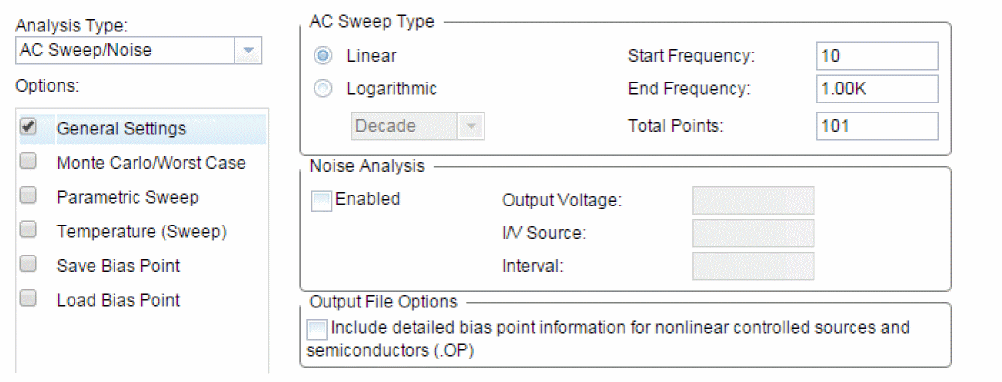
- Set the number of sweep points as follows:
To sweep frequency... Do this... linearly
Under AC Sweep Type, click Linear, and enter the total number of points in the sweep in the Total Points text box.
logarithmically by decades
Under AC Sweep Type, click Logarithmic, select
Decade(default), and enter the total number of points per decade in the Total Points text box.logarithmically by octaves
Under AC Sweep Type, click Logarithmic, select
Octave, and enter the total number of points per octave in the Total Points text box. - In the Start Frequency and End Frequency text boxes, enter the starting and ending frequencies, respectively, for the sweep.
- Click OK to save the simulation profile.
AC sweep setup in example.opj
If you look at the example circuit, EXAMPLE.OPJ, provided with your installed programs, you’ll find that its AC analysis is set up as shown in Figure 10-2.

Figure 10-1 Circuit diagram for EXAMPLE.OPJ.
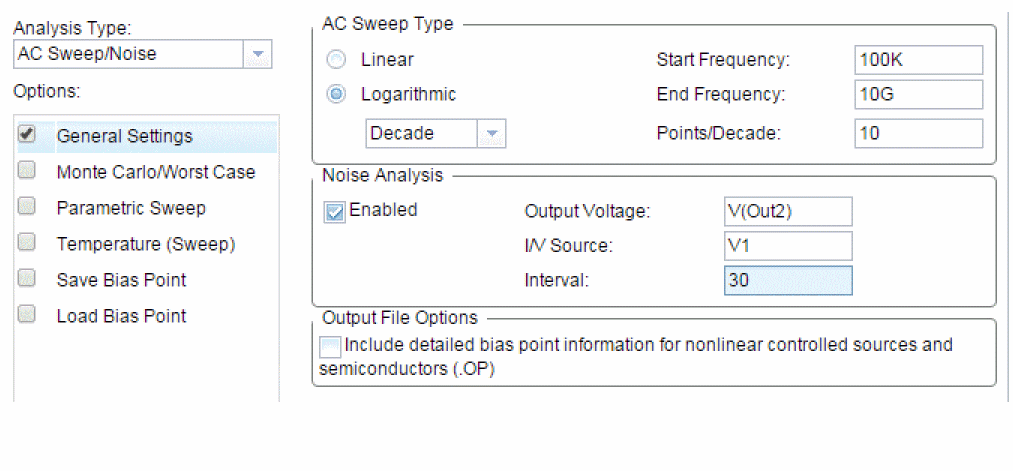
Figure 10-2 AC analysis setup for EXAMPLE.OPJ.
Frequency is swept from 100 kHz to 10 GHz by decades, with 10 points per decade. The V1 independent voltage source is the only input to an amplifier, so it is the only AC stimulus to this circuit. Magnitude equals 1 V and relative phase is left at zero degrees (the default). All other voltage sources have zero AC value.
How PSpice A/D treats nonlinear devices
An AC Sweep analysis is a linear or small-signal analysis. This means that nonlinear devices must be linearized to run the analysis.
What’s required to transform a device into a linear circuit
In order to transform a device (such as a transistor amplifier) into a linear circuit, you must do the following:
- Compute the DC bias point for the circuit.
- Compute the complex impedance and/or transconductance values for each device at this bias point.
- Perform the linear circuit analysis at the frequencies of interest by using simplifying approximations.
Example: Replace a bipolar transistor in common-emitter mode with a constant transconductance (collector current proportional to base-emitter voltage) and a number of constant impedances.
What PSpice A/D does
PSpice A/D automates this process for you. PSpice A/D computes the partial derivatives for nonlinear devices at the bias point and uses these to perform small-signal analysis.
Example: nonlinear behavioral modeling block
Suppose you have an analog behavioral modeling block that multiplies V(1) by V(2). Multiplication is a nonlinear operation. To run an AC sweep analysis on this block, the block needs to be replaced with its linear equivalent. To determine the linear equivalent block, PSpice A/D needs a known bias point.
Using a DC source
Consider the circuit shown below.
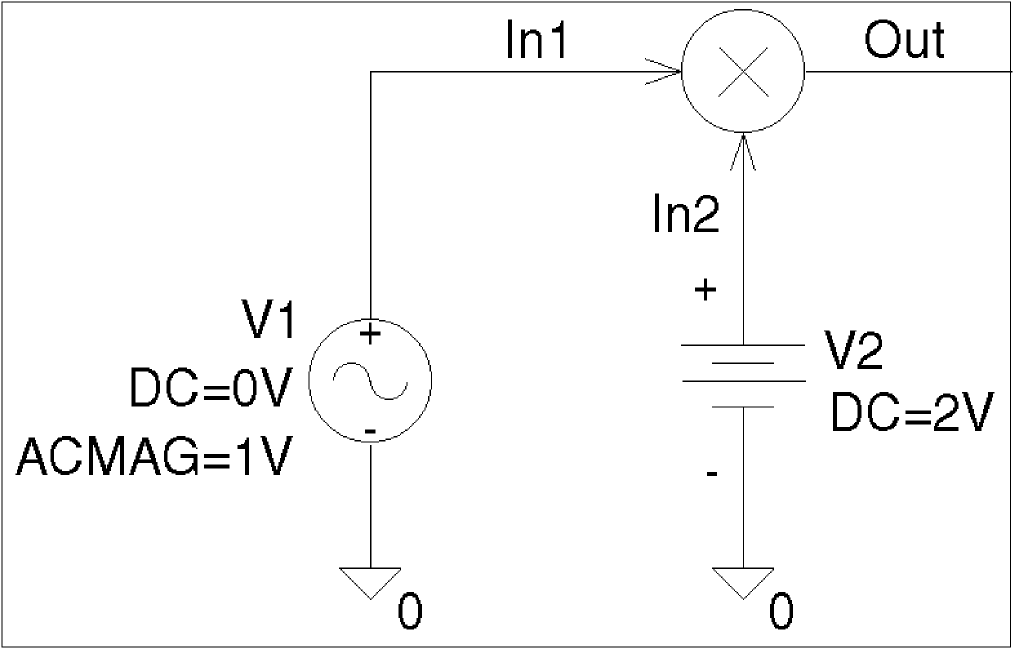
At the DC bias point, PSpice A/D calculates the partial derivatives which determine the linear response of the multiplier as follows:
![]()
![]()
For this circuit, this equation reduces to:
![]()
This means that the multiplier acts as an amplifier of the AC input with a gain that is set by the DC input.
Caution: multiplying AC sources
Suppose that you replace the 2 volt DC source in this example with an AC source with amplitude 1 and no DC value (DC=0). When PSpice A/D computes the bias point, there are no DC sources in the circuit, so all nodes are at 0 volts at the bias point. The linear equivalent of the multiplier block is a block with gain 0, which means that there is no output voltage at the fundamental frequency. This is exactly how a double-balanced mixer behaves. In practice, this is a simple multiplier.
Noise analysis
Setting up and running a noise analysis
The following procedure describes the minimum setup requirements for running a noise analysis. For more detail on any step, go to the pages referenced in the sidebars.
To set up and run an AC sweep
- Place and connect a voltage or current source with an AC input signal.
To find out how, see Setting up an AC stimulus. - Set up the AC sweep simulation specifications.
To find out how, see Setting up an AC analysis. - Set up the noise simulation specifications and enable the analysis in the AC Sweep/Noise portion of the Simulation Settings dialog box.
To find out how, see Setting up a noise analysis. - Click OK to save the simulation profile.
- From the PSpice menu, choose Run to start the simulation.
What is noise analysis?
When running a noise analysis, PSpice A/D calculates and reports the following for each frequency specified for the AC Sweep/Noise analysis:
- Device noise, which is the noise contribution propagated to the specified output net from every resistor and semiconductor device in the circuit; for semiconductor devices, the device noise is also broken down into constituent noise contributions where applicable
Example: Diodes have separate noise contributions from thermal, shot, and flicker noise. - Total output and equivalent input noise
This value... Means this... Output noise
RMS sum of all the device contributions propagated to a specified output net
Input noise
equivalent noise that would be needed at the input source to generate the calculated output noise in an ideal (noiseless) circuit
How PSpice A/D calculates total output and input noise
To calculate total noise at an output net, PSpice A/D computes the RMS sum of the noise propagated to the net by all noise-generating devices in the circuit.
To calculate the equivalent input noise, PSpice A/D then divides total output noise by the gain from the input source to the output net. This results in the amount of noise which, if injected at the input source into a noiseless circuit, would produce the total noise originally calculated for the output net.
Setting up a noise analysis
To set up the noise analysis
- From the PSpice menu, choose New Simulation Profile or Edit Simulation Profile. (If this is a new simulation, enter the name of the profile and click OK.)
The Simulation Settings dialog box appears.
- Choose
AC Sweep/Noisein the Analysis Type list box. - Under Options, select General Settings if it is not already enabled.
- Specify the AC sweep analysis parameters as described in Setting up an AC analysis.
- Select the Noise Analysis check box.
- Enter the noise analysis parameters as follows:
In this text box... Type this... Output Voltage
A voltage output variable of the form
V(node, [node]) where you want the total output noise calculated.I/V Source
The name of an independent current or voltage source where you want the equivalent input noise calculated.
If the source is in a lower level of a hierarchical schematic, separate the names of the hierarchical devices with periods (.). Example: U1.V2Interval
An integer n designating that at every n th frequency, you want to see a table printed in the PSpice output file (
.OUT) showing the individual contributions of all of the circuit’s noise generators to the total noise.In the Probe window, you can view the device noise contributions at every frequency specified in the AC sweep. The Interval parameter has no effect on what PSpice A/D writes to the Probe data file. - Click OK to save the simulation profile.
Analyzing Noise in the Probe window
You can use these output variable formats to view traces for device noise contributions and total input or output noise at every frequency in the analysis.
For a break down of noise output variables by supported device type, see Table 17-17.
| To view this... | Use this output variable... | Which is represented by this equation1... |
|---|---|---|
|
Flicker noise for a device |
NFID(device_name) |
noise ∝ |
|
Shot noise for a device |
NSID(device_name) |
For diodes and BJTs: noise For GaAsFETs, JFETs, and MOSFETs: noise ∝ |
|
Thermal noise for the RB, RC, RD, RE, RG, or RS constituent of a device, respectively |
NRB(device_name) |
noise ∝ |
|
Thermal noise generated by equivalent resistances in the output of a digital device |
NRLO(device_name) |
noise ∝ |
|
Total noise for a device |
NTOT(device_name) |
Sum of all contributors in device_name |
|
Total output noise for the circuit |
NTOT(ONOISE) |
|
|
RMS-summed output noise for the circuit |
V(ONOISE) |
RMS sum of all contributors
|
|
Equivalent input noise for the circuit |
V(INOISE) |
|
About noise units
| This type of noise output variable... | Is reported in these units... |
|---|---|
|
Device contribution of the form Nxxx |
|
|
Total input or output noise of the form V(ONOISE) or V(INOISE) |
|
Example
You can run a noise analysis on the circuit shown in Figure 10-1.
To run a noise analysis on the example:
In Capture, open the EXAMPLE.OPJ circuit provided in the \tools\pspice\capture_samples\anasim\example subdirectory.
- From the PSpice menu, choose New Simulation Profile or Edit Simulation Profile. (If this is a new simulation, enter the name of the profile and click OK.)
The Simulation Settings dialog box appears. - Choose AC Sweep/Noise in the Analysis type list box.
- Under Options, select General Settings if it is not already enabled.
- Enable the Noise Analysis check box.
- Enter the following parameters for the noise analysis:
Output Voltage
V(OUT2)
I/V Source
V1
Interval
30
For a description of the Interval parameter, see Interval.
These settings mean that PSpice A/D will calculate noise contributions and total output noise at net OUT2 and equivalent input noise from V1.
Figure 10-3 shows Probe traces for Q1’s constituent noise sources as well as total noise for the circuit after simulating. Notice that the trace for RMSSUM (at the top of the plot), which is a macro for the trace expression
SQRT(NTOT(Q1) + NTOT(Q2) + NTOT(Q3) + ... ),
exactly matches the total output noise, V(ONOISE), calculated by PSpice A/D.
To find out more about PSpice A/D macros, refer to PSpice A/D Help.
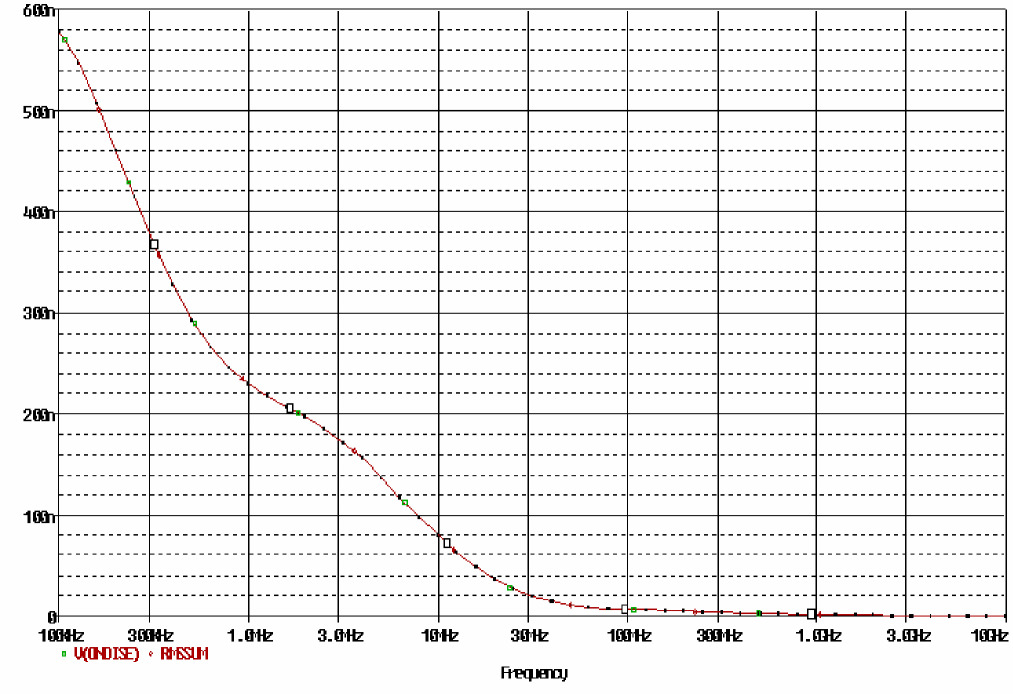
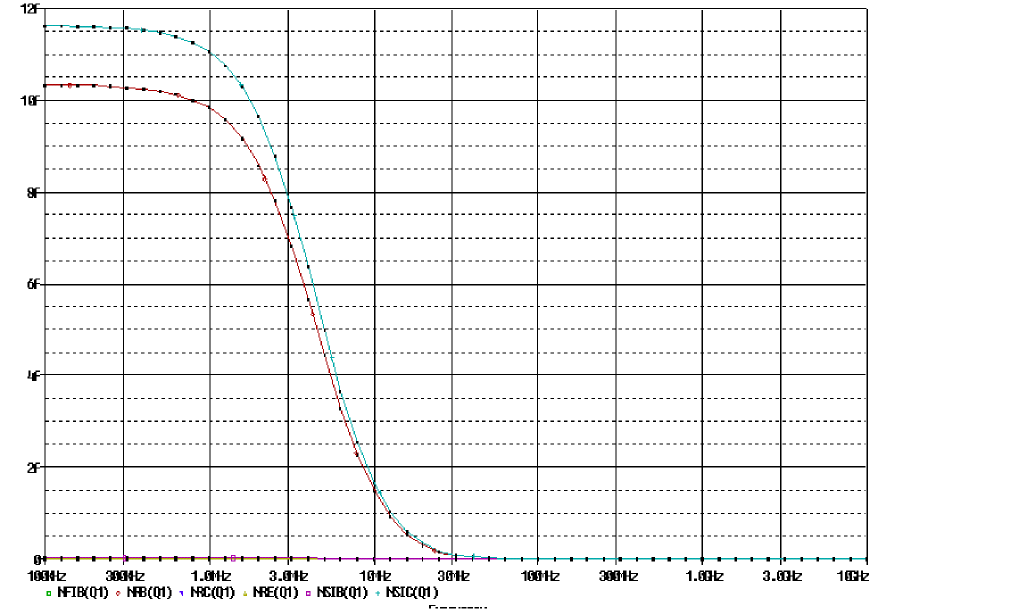
Figure 10-3 Device and total noise traces for EXAMPLE.OPJ.
Frequency is swept from 100 kHz to 10 GHz by decades, with 10 points per decade. The V1 independent voltage source is the only input to an amplifier, so it is the only AC stimulus to this circuit. Magnitude equals 1 V and relative phase is left at zero degrees (the default). All other voltage sources have zero AC value.
To find out more about the equations that describe noise behavior, refer to the appropriate device type in the Analog Devices chapter in the PSpice A/D Reference Guide.
View the next document: 11 - Parametric And Temperature Analysis
If you have any questions or comments about the OrCAD X platform, click on the link below.
Contact Us
